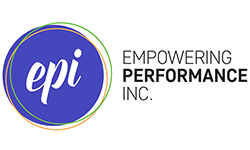A Note from Michelle: How to Be an Everyday Creative
Sometimes things are just out in the zeitgeist. Creative thinking seems to be one of them these days. I had a lot of fun discussing the creative mindset with young professionals at the St. Paul Area Chamber of Commerce recently. They were engaged and contributed enthusiastically to the conversation about how we can all jump-start our creative sides. I left feeling energized and ready to share more insights on creativity this month.
Just as I was sitting down to write, a post from psychologist Ron Friedman popped into my inbox. I felt a tinge of dismay because he was talking about some of the exact things I wanted to cover. But then I got excited and thought, “Well, all right! We’re onto something here!” (Now, Dr. Friedman doesn’t know us, but we practically consider him a friend of EPI. We love his book The Best Place to Work so much we often include it as a resource in our leadership courses. Check out some of his articles here.)
As Friedman discusses, creativity isn’t solely the realm of artists. We are all creative.
Because creativity is really about finding an original way to solve a problem.
For artists, that problem may be how to express their own emotions or spark an emotional reaction in others through shape and color. And a writer may want to figure out how to immerse readers in the story through narrative devices or plot twists.
But what about the rest of us “everyday” creatives?
The good news is we all have creative potential (as we covered in 6 Creativity Myths That May Be Limiting Your Potential). However, we may not even realize when or how we’re being creative. Preparing for a dinner party, navigating food preferences and furniture placement? You’re being creative. Helping a client define their pain points? You’re stringing together thoughts in ways that are situationally unique.
Guess what? That’s also being creative. Every time we’re faced with new parameters, at work or at home, we draw on inner resources to adapt and change. This is all creative thinking in action. And the most heartening news is that we can all hone our creative thinking skills. Often through simple shifts throughout the day.
Crank up your creative thinking with these 10 tips.
Get physical. Take a walk. Run in place. Celebrate small successes with vigorous arm pumps. Most of all, don’t spend too much time in one position, whether it’s sitting or standing. Move as much as possible.
Change it up. If you work most of the time within groups, take a contemplative break by yourself. If you predominantly work alone, collaborate at the local coffee shop with a colleague to get your creative juices flowing.
Spark connections. Try combining random words or images in unlikely ways to trigger new mental connections. And double down by doing it while sitting on an exercise ball!
Seek fresh eyes. When you’re stuck creatively, ask for insight from a team member who hasn’t been working on the project and can approach it without preconceptions. Become inspired by someone else’s viewpoint. Then take it further.
Cultivate curiosity. Ask questions. Show an interest to become interested. Curiosity is the greatest boon to creative thinking.
Explore your other. Take a deeper dive into less predominant aspects of your personality. If you’re an extrovert known for your awesome barbecue skills, try cooking an elaborate vegetarian meal for dinner alone. You may ignite a whole new perspective.
Search and solve. According to creativity guru Robert Root-Bernstein in this Psychology Today article,
“The most important thing anyone can do to improve creativity is to find unsolved dilemmas to address.”
Play, fail, play again. Commune with your inner child; play at something different. And don’t be afraid to fail. Learn from it and try again. Just keep it fun.
Build in laughter breaks. Take time to laugh every day. Keep a library of books, movies, or YouTube cat videos that always amuse you. Or spend a few minutes talking with the coworker who never fails to make you chuckle. Writer and mediator David Evans calls creativity “off-road thinking.” And he explains that “Humor helps prepare your brain for those off-road excursions.”
Distract yourself. You can’t force the creative flow. But you can trick it. Let your unconscious mind free-associate while you focus on a rote task. You may find yourself shouting, “Eureka!” in the middle of a deadly dull spreadsheet.
A good idea has a life of its own. And creative thinking is an idea whose time has come.
As we noted in Creativity at Work – What Robots Can’t Do, creativity will be one of the most necessary workplace skills by 2020. That’s why I’m only one of many people reflecting on it these days. You should be too.
Michelle Kelly, CEO (Chief Enjoyment Officer)


